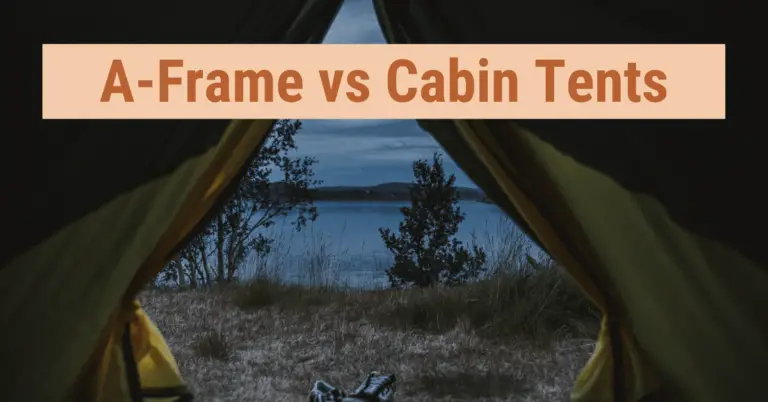When comparing an a-frame tent vs cabin tent, there are some important aspects to cabin tents that should be considered before you make your decision! Extra space from cabin tents comes with some tradeoffs that may change your plans.
We’ve broken down the major similarities and differences of common tent types to help you make the right decision for your next outdoor adventure!
A-Frame Tent vs Cabin Tent
First, let’s break down each type of tent:
Major Differences
The biggest differences between an a-frame tent vs cabin tent are capacity and portability. Cabin tents are built to be able to stand in with many people. They are available in sizes of up to 12 people for large families or groups that want multiple rooms available for increased privacy. Cabin tent rooms are usually made with a piece of tent fabric between portions of the tent that are able to be opened and closed. In comparison, a-frame tents cap out around 4 people.
Both a-frame and cabin tents typically employ a two-layer design to repel rain but cabin tent layers don’t go nearly as far as dome tents usually do. As seen in the photos above, Cabin tents use a single layer of rain protection for up to 75% of each side compared to an a-frame tent only relying on single layers on just the bottom of the tent itself.
While they should both offer good rain protection, a-frame tents may be more reliable in harsher storms since their structure allows wind to flow around the tent better and the rain fly offers more coverage.
Cabin tents can be slightly more challenging to set up but if you have the labor to help out (and fill the large capacity tent), it is significantly easier. A-frames are less easy than a dome tent or an instant tent but can typically be set up by even just one person with enough patience.
Best Uses For A-frame & Cabin Tents
Each of these types of tents is great for both family and car camping! Smaller families may prefer an a-frame’s smaller package or enjoy the larger amount of space offered by cabin tents. A-frame tents can be used for backpacking (although there are better options) but cabin tents almost always have too large of a package to reasonably pack and walk miles with.
A-Frame | Cabin | |
Feature Comparison | A-Frame Tent vs Cabin Tent
While cabin tents have the advantage of capacity, a-frame tents are slightly more versatile and likely to offer longer-lasting rain protection with the more comprehensive dual-layer rain fly. While you can find each type of tent at a wide price range, you can usually find a value brand a-frame at a lower price than similar capacity cabin tents. Not sold on a-frames? We’d recommend a dome tent for any type of camper from beginner to expert!
Product | A-Frame | Cabin |
Sturdiness | ||
Capacity | ||
Cost | ||
Portability | ||
Lifespan |
Want more?
Check out our infographic and larger article covering the ten most common tent types or use our tent finding tool to quickly find the tents that suit your needs!
More A-Frame Tent Comparisons
➤ A-Frame Tent vs Backpacking Tent
➤ A-Frame Tent vs Suspended Tent







